Overview
- Brief Narrative
- Medal depicting Jewish Hungarian Bela Komjadi, awarded to a cousin of Eva Hevesi Ehrlich by the Hungarian Swimming Association in 1934. Known as “the father of Hungarian water polo,” Komjadi established a program resulting in numerous European and Olympic gold medals. Eva was living in Budapest, Hungary, with her parents, Ferenc and Magda Hevesi, when the war in Europe began in September 1939. Ferenc was a rabbi at the Dohány Street synagogue under his father, Simon Hevesi, who was chief rabbi of Hungary. When Simon died in 1943, Ferenc and a colleague succeeded him as co-chief rabbis. Hungary was allied with Germany, but when the Hungarian government began seeking a ceasefire with the Allies, the German army occupied Hungary on March 19, 1944. When the radically antisemitic, German-backed Arrow Cross Party took control of the government on October 15, Eva and her family went into hiding. The section of the city they were in was liberated by the Soviet army on January 16, 1945. Eva’s paternal grandmother had starved to death during the occupation, her maternal grandmother died shortly after liberation, and her fiancé was shot and thrown into the Danube River. Ferenc became a chaplain for the Hungarian army, and returned to his former rabbinical duties. Eva returned to college and met a Hungarian-American soldier with the American military mission. In the fall of 1946, Eva immigrated to the United States with her husband, followed shortly by her father and mother. Eva and her husband divorced in 1949. She then married Bernard Ehrlich in 1950.
- Date
-
issue:
1934
- Geography
-
received:
Hungary
- Credit Line
- United States Holocaust Memorial Museum Collection, Gift of Eva Ehrlich
- Markings
- front, lower edge, embossed : KOMJÁDI
front, on lower edge of neck, engraved : CS.G. [Csorba Geza]
back, upper and lower edges, embossed : MAGYAR USZÓ SZÖVETSEG / 1934 [Hungarian Swimming Association / 1934] - Contributor
-
Subject:
Eva Ehrlich
Previous owner: Eva Ehrlich
Designer: Géza Csorba
Issuer: Magyar Uszó Szövetseg
- Biography
-
Eva Ehrlich (1924-2009) was born Eva Hevesi in Budapest, Hungary to Dr. Ferenc (1898-1952) and Magda (nee Rottenstein, 1906-1977) Hevesi. Ferenc worked as a rabbi in the city of Székesfehérvár, Hungary. In 1930, the family returned to Budapest, where they shared a large apartment with Ferenc’s parents, Simon (1868-1943) and Janka (Johanna, 1872-1945) Hevesi. Simon was the chief rabbi of Hungary, and Ferenc worked under his father at the Dohany Street synagogue. The combined household was very traditional, and they observed all of the holidays and ate exclusively kosher. They had a close extended family, and they regularly met at Eva’s grandparents’ home for meals. When Eva was around 9 or 10, she moved with her parents into their own apartment. She was educated at private elementary and secondary schools, where she learned French, German and English. Although Eva had many non-Jewish friends as a child, she did experience some antisemitism. During a Friday night service in 1932, her father had to disarm a shooter who came into his synagogue.
Things became worse for the Jewish population as Hungary began instituting anti-Jewish policies modeled after German laws in 1938, and then joined the Axis alliance in November 1940. Eva continued attending school alongside her classmates, most of whom were also Jewish. However, some of her male friends were conscripted into forced labor battalions to support the war effort. Eva and her family were able to keep abreast of the war by illegally listening to Allied radio broadcasts. When Eva graduated high school in 1942, most Jews were prohibited from attending university. After much difficulty, a connection of the family was able to get Eva enrolled, but she was prohibited from attending medical school as she had wanted. In 1943, Eva’s grandfather, Simon, died. Ferenc and a colleague succeeded him as co-chief rabbis of Hungary.
Following Hungarian attempts to sign an armistice with the Allies, the German army occupied Hungary on March 19, 1944, and Adolf Eichmann arrived in Budapest to personally oversee the occupation. Two weeks later, the occupation authorities decreed that all Jews six years and older were required to wear a yellow Star of David. Eva and her family’s valuables were confiscated, and they were removed from their apartment and forced into one they had to share with another family. Curfews were slowly imposed, and food became scarce. The family was forced to relocate again, into a single room apartment crowded with 20 people. No longer allowed to attend school, Eva began working at the Jewish community center, compiling lists of all those in the community. That summer, she also became engaged to William Vasadi (?-1944), an attorney who also worked at the community center, following his forced service in a labor battalion. Eva and her mother purchased two sets of false papers in case they needed to escape, but did not obtain any for Ferenc, as he was too well-known to be able to use them.
On October 15, the radically antisemitic, German-backed Arrow Cross Party seized power of the Hungarian government. They began carrying out violent attacks against Jews, forcing many into hiding. William went into hiding in a Swiss-protected building, Ferenc went to the home of a Gentile cousin of Magda’s, while family friends helped Eva and Magda secure rented lodgings. Out of fear of discovery, Eva and Magda moved every few days, aided by members of the underground resistance. William begged her to join him at the Swiss building, but she did not want leave her mother. A few days later, William’s protected house was raided by Arrow Cross soldiers and he was shot and thrown into the Danube River. In November, a closed Jewish ghetto was created in the area around the Dohany Street synagogue. Ferenc’s brother and sister-in-law were forced into the ghetto, but were able to escape.
Ferenc was thrown out of their relative’s home in December, and he went to the sanatorium where his mother was staying, which was owned by an American doctor. A rabbi in the Judenrat alerted the authorities, but the doctor helped Ferenc escape again, and he was taken into an apartment owned by a retired army colonel. Eva and Magda eventually went to the same apartment building, and were placed in the basement with a group of Gentiles hiding from the air raids. They remained there until their section of the city, including the ghetto, was liberated by the Soviet army on January 16, 1945. The remainder of the city was liberated the following month.
When they came out from hiding, Eva and her family were able to find Magda’s parents, Moritz and Erna Rottenstein, who had survived in a Jewish hospital. Erna was very ill, and died a short time later. Ferenc’s mother had been in the same sanatorium where he had hidden, but she starved to death after the nurse who was caring for her began stealing her food. Eva accompanied her father to the synagogue, where they found huge piles of unidentifiable Jewish corpses, frozen by the winter temperatures. Ferenc presided over a mass service and burial. Long lines soon formed for individual burials.
Near the end of February, Eva and her parents returned to their apartment, only to find it had been emptied of all their belongings by the building janitor. After he was caught, the janitor was able to get their belongings back. Eva returned to college as soon as she could, and was given credits for the time she had lost. Ferenc became a chaplain for the Hungarian army, and returned to his former rabbinical duties. The American military mission arrived in Budapest, and Eva met a Hungarian-American soldier, Adrian Heller. They got married on October 8, 1946, and Eva immigrated with him to the United States.
In the fall of 1946, Ferenc traveled to England and the United States, where he Anglicized his name to Francis. He was sponsored by the American Joint Distribution Committee, and gave speeches on behalf of the Hungarian Jewry. On February 2, 1947, Francis presided over Eva’s religious wedding ceremony in New York City. Magda was also granted permission to travel to attend the wedding. Before Eva’s parents could return to Budapest, they were warned that Francis was being accused of a crime and that he should stay in the US.
Eva and her husband divorced in the summer of 1949, and she moved with her parents to Georgia, where Francis led a congregation. They later moved to Washington, D.C., where Eva worked for the Library of Congress and met Bernard Ehrlich, who she married in 1950. Francis was invited to lead a congregation in Hawaii, where he died in 1952. Magda lived with Eva and Bernard until her death in 1977, and they raised three daughters.
Physical Details
- Language
- Hungarian
- Classification
-
Awards
- Category
-
Medals
- Object Type
-
Sports--Medals (lcsh)
- Genre/Form
- Medals.
- Physical Description
- Circular, gold colored metal medal with an embossed bust of Komjadi, a bald man in left profile with a strong brow, large nose, and pointed chin. The slightly concave medal has a smooth back with a raised rim and smooth edge. There is embossed text on the front and back encircling the edge.
- Dimensions
- overall: | Depth: 0.250 inches (0.635 cm) | Diameter: 2.375 inches (6.032 cm)
- Materials
- overall : metal
Rights & Restrictions
- Conditions on Access
- No restrictions on access
- Conditions on Use
- No restrictions on use
Keywords & Subjects
- Topical Term
- Faith (Judaism) Hiding places--Hungary--Budapest. Holocaust, Jewish (1939-1945)--Hungary--Budapest--Personal narratives. Jews--Persecution--Hungary--Budapest--Biography. Jewish families--Hungary. Rabbis--Hungary--Budapest--Biography. Water polo. World War, 1939-1945--Jews--Hungary--Budapest--Personal narratives. Synagogues
- Geographic Name
- Budapest (Hungary) New York (N.Y.) United States.
- Personal Name
- Hevesi, Simon, 1868-1943.
Administrative Notes
- Legal Status
- Permanent Collection
- Provenance
- The medal was donated to the United States Holocaust Memorial Museum in 1990 by Eva Ehrlich.
- Funding Note
- The cataloging of this artifact has been supported by a grant from the Conference on Jewish Material Claims Against Germany.
- Record last modified:
- 2024-02-21 07:11:17
- This page:
- https://collections.ushmm.org/search/catalog/irn3331
Download & Licensing
In-Person Research
- By Appointment
- Request 21 Days in Advance of Visit
- Plan a Research Visit
- Request to See This Object
Contact Us
Also in Ferenc Hevesi family collection
The collection consists of Jewish religious attire, athletic medals, commemorative plaques, and copy prints relating to the experiences of Rabbis Simon and Ferenc Hevesi and their family in Budapest, Hungary, before and during the Holocaust.
Date: 1923-1944
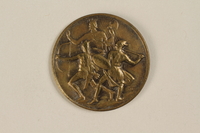
Orszagos Leventeverseny medal owned by a Hungarian Jewish family
Object
Medal for the 1942 Orszagos Leventeverseny (National Levente Competition), awarded to a member of Eva Hevesi Ehrlich’s family. The levente movement provided a framework for government-mandated physical education for Hungarian male youths under 21. It was increasingly militarized, and became controlled by the Ministry of Defense in 1941. A branch for girls was created in June 1942. Eva was living in Budapest, Hungary, with her parents, Ferenc and Magda Hevesi, when the war in Europe began in September 1939. Ferenc was a rabbi at the Dohány Street synagogue under his father, Simon Hevesi, who was chief rabbi of Hungary. When Simon died in 1943, Ferenc and a colleague succeeded him as co-chief rabbis. Hungary was allied with Germany, but when the Hungarian government began seeking a ceasefire with the Allies, the German army occupied Hungary on March 19, 1944. When the radically antisemitic, German-backed Arrow Cross Party took control of the government on October 15, Eva and her family went into hiding. The section of the city they were in was liberated by the Soviet army on January 16, 1945. Eva’s paternal grandmother had starved to death during the occupation, her maternal grandmother died shortly after liberation, and her fiancé was shot and thrown into the Danube River. Ferenc became a chaplain for the Hungarian army, and returned to his former rabbinical duties. Eva returned to college and met a Hungarian-American soldier with the American military mission. In the fall of 1946, Eva immigrated to the United States with her husband, followed shortly by her father and mother. Eva and her husband divorced in 1949. She then married Bernard Ehrlich in 1950.
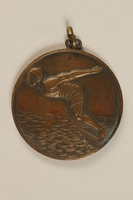
Diving medal owned by a Hungarian Jewish family
Object
Medal for diving, awarded to a cousin of Eva Hevesi Ehrlich in Budapest, Hungary. Eva was living in Budapest, Hungary, with her parents, Ferenc and Magda Hevesi, when the war in Europe began in September 1939. Ferenc was a rabbi at the Dohány Street synagogue under his father, Simon Hevesi, who was chief rabbi of Hungary. When Simon died in 1943, Ferenc and a colleague succeeded him as co-chief rabbis. Hungary was allied with Germany, but when the Hungarian government began seeking a ceasefire with the Allies, the German army occupied Hungary on March 19, 1944. When the radically antisemitic, German-backed Arrow Cross Party took control of the government on October 15, Eva and her family went into hiding. The section of the city they were in was liberated by the Soviet army on January 16, 1945. Eva’s paternal grandmother had starved to death during the occupation, her maternal grandmother died shortly after liberation, and her fiancé was shot and thrown into the Danube River. Ferenc became a chaplain for the Hungarian army, and returned to his former rabbinical duties. Eva returned to college and met a Hungarian-American soldier with the American military mission. In the fall of 1946, Eva immigrated to the United States with her husband, followed shortly by her father and mother. Eva and her husband divorced in 1949. She then married Bernard Ehrlich in 1950.
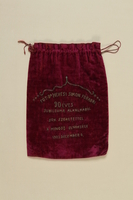
Embroidered purple tallit bag used by two Hungarian rabbis
Object
Embroidered tallit bag, given to Rabbi Simon Hevesi in 1923 and later used by his son Rabbi Ferenc Hevesi, after his death in 1943. Simon became a rabbi in Budapest’s Dohány Street synagogue in 1905. He became a leader in the community and was elected chief rabbi of Hungary in 1927. In 1930, Simon’s son, Ferenc, moved to Budapest with his wife and daughter, and also became a rabbi at the Dohány synagogue. During his tenure in Budapest, Simon founded or served as a board member of numerous institutions and organizations, and was a prolific writer and editor of Jewish scholarly works. When Simon died in 1943, Ferenc and a colleague succeeded him as co-chief rabbis. Hungary was allied with Germany, but when the Hungarian government began seeking a ceasefire with the Allies, the German army occupied Hungary on March 19, 1944. When the radically antisemitic, German-backed Arrow Cross Party took control of the government on October 15, Eva and her family went into hiding. The section of the city they were in was liberated by the Soviet army on January 16, 1945. Ferenc became a chaplain for the Hungarian army, and returned to his former rabbinical duties. In the fall of 1946, Ferenc traveled to England and the United States, where he Anglicized his name to Francis. He gave speeches on behalf of the Hungarian Jewry, and presided over his daughter’s religious wedding ceremony in New York City. Before he and his wife could return home, they were warned that Francis would be persecuted. They stayed in the US where Francis became rabbi for a succession of congregations in Georgia and Hawaii.
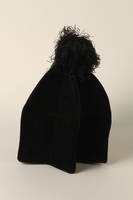
Cantor’s black tufted hat worn by a Hungarian rabbi
Object
Cantor’s hat worn during services by Rabbi Ferenc Hevesi, who served as co-chief rabbi of Hungary between 1943 and 1946. The cantor (hazan or chazzan) is the synagogue’s professional prayer leader. Ferenc joined the Dohany Street synagogue as a rabbi when he moved with his wife, Magda, and daughter, Eva, to Budapest in 1930. When his father, Rabbi Simon Hevesi, died in 1943, Ferenc succeeded him as co-chief rabbi of Hungary. Hungary was allied with Germany, but when the Hungarian government began seeking a ceasefire with the Allies, the German army occupied Hungary on March 19, 1944. Afterward, Ferenc and his family were forced out of their apartment into one shared with other families. A curfew was imposed on Jews and Ferenc could only hold services at the synagogue if it did not conflict with the curfew. As chief rabbi, Ferenc was constantly harassed by the Germans, and pressured to become part of the Judenrat, which he refused. When the radically antisemitic, German-backed Arrow Cross Party took control of the government on October 15, Ferenc and his family went into hiding. The section of the city they were in was liberated by the Soviet army on January 16, 1945. Ferenc became a chaplain for the Hungarian army, and returned to his former rabbinical duties. In the fall of 1946, Ferenc traveled to England and the United States, where he Anglicized his name to Francis. He gave speeches on behalf of the Hungarian Jewry, and presided over his daughter’s religious wedding ceremony in New York City. They stayed in the US, where Francis became rabbi for a succession of congregations in Georgia and Hawaii.
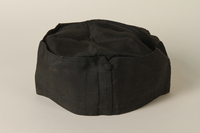
Black yarmulke worn by a Hungarian rabbi
Object
Black yarmulke owned by Rabbi Simon Hevesi, likely acquired in 1939, when he traveled to the United States to receive an honorary doctorate from the Jewish Theological Society of America. A yarmulke is a skullcap worn by observant Jewish males. Simon Handler became an ordained rabbi in 1894, and was appointed chief rabbi in Kassa, Hungary (now Košice, Slovakia) followed by Lugos (now Lugoj, Romania) in 1897. As part of a pilgrimage study trip to Palestine, Simon met the leaders of the Jewish community in Budapest. At their invitation, Simon moved with his wife and five children to Budapest in 1905 and changed their last name to Hevesi. As a rabbi in the Dohány Street synagogue, Simon became a leader in the community, was a beloved speaker, and held a professorship in oratory at the Rabbinical Institute. He was elected chief rabbi of Hungary in 1927 and became president of the National Rabbinical Association. In 1930, Simon’s son, Ferenc, moved to Budapest with his wife and daughter, and also became a rabbi at the Dohány synagogue. In 1939, Simon traveled to the United States, and was given an honorary doctorate by the Jewish Theological Society of America. During his tenure in Budapest, Simon founded or served as a board member of numerous institutions and organizations, and was a prolific writer and editor of Jewish scholarly works. When Simon died in 1943, Ferenc and a colleague succeeded him as co-chief rabbis.
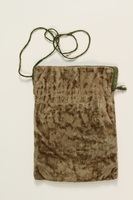
Set of tefillin with a green pouch worn by a Hungarian rabbi
Object
Pair of tefillin and pouch owned by Rabbi Simon Hevesi, and later used by his son, Rabbi Ferenc Hevesi. Simon served as chief rabbi of Hungary between 1927 and 1943. Tefillin are small boxes containing prayers attached to leather straps and worn by Orthodox Jewish males during morning prayers. Simon Handler became an ordained rabbi in 1894, and was appointed chief rabbi in Kassa, Hungary (now Košice, Slovakia) followed by Lugos (now Lugoj, Romania) in 1897. As part of a pilgrimage study trip to Palestine, Simon met the leaders of the Jewish community in Budapest. At their invitation, Simon moved with his wife and five children to Budapest in 1905 and changed their last name to Hevesi. As a rabbi in the Dohány Street synagogue, Simon became a leader in the community, was a beloved speaker, and held a professorship in oratory at the Rabbinical Institute. He was elected chief rabbi of Hungary in 1927 and became president of the National Rabbinical Association. In 1930, Simon’s son, Ferenc, moved to Budapest with his wife and daughter, and also became a rabbi at the Dohány synagogue. In 1939, Simon traveled to the United States, and was given an honorary doctorate by the Jewish Theological Society of America. During his tenure in Budapest, Simon founded or served as a board member of numerous institutions and organizations, and was a prolific writer and editor of Jewish scholarly works. When Simon died in 1943, Ferenc and a colleague succeeded him as co-chief rabbis.
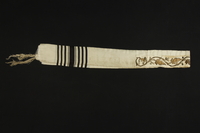
Striped silk tallit worn by a Hungarian rabbi
Object
Tallit owned by Rabbi Ferenc Hevesi, who served as co-chief rabbi in Hungary between 1943 and 1946. A tallit is a specialized shawl worn by Orthodox Jewish males during morning prayers. Ferenc joined the Dohany Street synagogue as a rabbi when he moved with his wife, Magda, and daughter, Eva, to Budapest in 1930. When his father, Rabbi Simon Hevesi, died in 1943, Ferenc succeeded him as co-chief rabbi of Hungary. Hungary was allied with Germany, but when the Hungarian government began seeking a ceasefire with the Allies, the German army occupied Hungary on March 19, 1944. Afterward, Ferenc and his family were forced out of their apartment into one shared with other families. A curfew was imposed on Jews and Ferenc could only hold services at the synagogue if it did not conflict with the curfew. As chief rabbi, Ferenc was constantly harassed by the Germans, and pressured to become part of the Judenrat, which he refused. When the radically antisemitic, German-backed Arrow Cross Party took control of the government on October 15, Ferenc and his family went into hiding. The section of the city they were in was liberated by the Soviet army on January 16, 1945. Ferenc became a chaplain for the Hungarian army, and returned to his former rabbinical duties. In the fall of 1946, Ferenc traveled to England and the United States, where he Anglicized his name to Francis. He gave speeches on behalf of the Hungarian Jewry, and presided over his daughter’s religious wedding ceremony in New York City. They stayed in the US, where Francis became rabbi for a succession of congregations in Georgia and Hawaii.
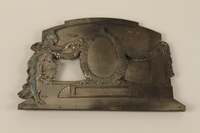
Commemorative silver plaque presented to a Hungarian rabbi
Object
Silver engraved plaque honoring Dr. Simon Hevesi, chief rabbi of Hungary, for his service to the nation’s Jewish community. Simon Handler became an ordained rabbi in 1894, and was appointed chief rabbi in Kassa, Hungary (now Košice, Slovakia) followed by Lugos (now Lugoj, Romania) in 1897. As part of a pilgrimage study trip to Palestine, Simon met the leaders of the Jewish community in Budapest. At their invitation, Simon moved with his wife and five children to Budapest in 1905 and changed their last name to Hevesi. As a rabbi in the Dohány Street synagogue, Simon became a leader in the community, was a beloved speaker, and held a professorship in oratory at the Rabbinical Institute. He was elected chief rabbi of Hungary in 1927 and became president of the National Rabbinical Association. In 1930, Simon’s son, Ferenc, moved to Budapest with his wife and daughter, and also became a rabbi at the Dohány synagogue. In 1939, Simon traveled to the United States, and was given an honorary doctorate by the Jewish Theological Society of America. During his tenure in Budapest, Simon founded or served as a board member of numerous institutions and organizations, and was a prolific writer and editor of Jewish scholarly works. When Simon died in 1943, Ferenc and a colleague succeeded him as co-chief rabbis.
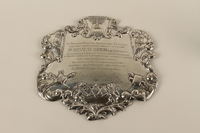
Silver plaque honoring a Hungarian rabbi for 20 years of leadership
Object
Ornate, engraved silver plaque presented to Dr. Simon Hevesi, chief rabbi of Hungary, by the National Hungarian Jewish Cultural Association in recognition of his 20 years of service. Simon Handler became an ordained rabbi in 1894, and was appointed chief rabbi in Kassa, Hungary (now Košice, Slovakia) followed by Lugos (now Lugoj, Romania) in 1897. As part of a pilgrimage study trip to Palestine, Simon met the leaders of the Jewish community in Budapest. At their invitation, Simon moved with his wife and five children to Budapest in 1905 and changed their last name to Hevesi. As a rabbi in the Dohány Street synagogue, Simon became a leader in the community, was a beloved speaker, and held a professorship in oratory at the Rabbinical Institute. He was elected chief rabbi of Hungary in 1927 and became president of the National Rabbinical Association. In 1930, Simon’s son, Ferenc, moved to Budapest with his wife and daughter, and also became a rabbi at the Dohány synagogue. In 1939, Simon traveled to the United States, and was given an honorary doctorate by the Jewish Theological Society of America. During his tenure in Budapest, Simon founded or served as a board member of numerous institutions and organizations, and was a prolific writer and editor of Jewish scholarly works. When Simon died in 1943, Ferenc and a colleague succeeded him as co-chief rabbis.
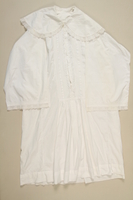
White kittel used by Rabbi Ferenc Hevesi on High Holidays
Object
White kittel with belt for high holiday services, brought by Rabbi Ferenc Hevesi from Budapest, Hungary, to New York City in the fall of 1946. The white color represents the angelic purity that wearers hope to achieve through prayer. Kittels are often worn as burial shrouds, though Ferenc’s unexpected death prevented this. Ferenc joined the Dohany Street synagogue as a rabbi when he moved with his wife, Magda, and daughter, Eva, to Budapest in 1930. When his father, Rabbi Simon Hevesi, died in 1943, Ferenc succeeded him as co-chief rabbi of Hungary. Hungary was allied with Germany, but when the Hungarian government began seeking a ceasefire with the Allies, the German army occupied Hungary on March 19, 1944. Afterward, Ferenc and his family were forced out of their apartment into one shared with other families. A curfew was imposed on Jews and Ferenc could only hold services at the synagogue if it did not conflict with the curfew. As chief rabbi, Ferenc was constantly harassed by the Germans, and pressured to become part of the Judenrat, which he refused. When the radically antisemitic, German-backed Arrow Cross Party took control of the government on October 15, Ferenc and his family went into hiding. The section of the city they were in was liberated by the Soviet army on January 16, 1945. Ferenc became a chaplain for the Hungarian army, and returned to his former rabbinical duties. In the fall of 1946, Ferenc traveled to England and the United States, where he Anglicized his name to Francis. He gave speeches on behalf of the Hungarian Jewry, and presided over his daughter’s religious wedding ceremony in New York City. They stayed in the US, where Francis became rabbi for a succession of congregations in Georgia and Hawaii.
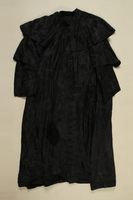
Black robe used by a Rabbi Ferenc Hevesi for everyday services
Object
Black robe with detachable capelet used for everyday religious services, brought by Rabbi Ferenc Hevesi from Budapest, Hungary, to New York City in the fall of 1946. Ferenc joined the Dohany Street synagogue as a rabbi when he moved with his wife, Magda, and daughter, Eva, to Budapest in 1930. When his father, Rabbi Simon Hevesi, died in 1943, Ferenc succeeded him as co-chief rabbi of Hungary. Hungary was allied with Germany, but when the Hungarian government began seeking a ceasefire with the Allies, the German army occupied Hungary on March 19, 1944. Afterward, Ferenc and his family were forced out of their apartment into one shared with other families. A curfew was imposed on Jews and Ferenc could only hold services at the synagogue if it did not conflict with the curfew. As chief rabbi, Ferenc was constantly harassed by the Germans, and pressured to become part of the Judenrat, which he refused. When the radically antisemitic, German-backed Arrow Cross Party took control of the government on October 15, Ferenc and his family went into hiding. The section of the city they were in was liberated by the Soviet army on January 16, 1945. Ferenc became a chaplain for the Hungarian army, and returned to his former rabbinical duties. In the fall of 1946, Ferenc traveled to England and the United States, where he Anglicized his name to Francis. He gave speeches on behalf of the Hungarian Jewry, and presided over his daughter’s religious wedding ceremony in New York City. They stayed in the US, where Francis became rabbi for a succession of congregations in Georgia and Hawaii.
Striped tallit worn by two Hungarian rabbis
Object
Tallit, given to Rabbi Simon Hevesi in 1923 and later used by his son Rabbi Ferenc Hevesi, after his death in 1943. Simon became a rabbi in Budapest’s Dohány Street synagogue in 1905. He became a leader in the community and was elected chief rabbi of Hungary in 1927. In 1930, Simon’s son, Ferenc, moved to Budapest with his wife and daughter, and also became a rabbi at the Dohány synagogue. During his tenure in Budapest, Simon founded or served as a board member of numerous institutions and organizations, and was a prolific writer and editor of Jewish scholarly works. When Simon died in 1943, Ferenc and a colleague succeeded him as co-chief rabbis. Hungary was allied with Germany, but when the Hungarian government began seeking a ceasefire with the Allies, the German army occupied Hungary on March 19, 1944. When the radically antisemitic, German-backed Arrow Cross Party took control of the government on October 15, Eva and her family went into hiding. The section of the city they were in was liberated by the Soviet army on January 16, 1945. Ferenc became a chaplain for the Hungarian army, and returned to his former rabbinical duties. In the fall of 1946, Ferenc traveled to England and the United States, where he Anglicized his name to Francis. He gave speeches on behalf of the Hungarian Jewry, and presided over his daughter’s religious wedding ceremony in New York City. Before he and his wife could return home, they were warned that Francis would be persecuted. They stayed in the US where Francis became rabbi for a succession of congregations in Georgia and Hawaii.
Ferenc Hevesi papers
Document
The collection documents the Holocaust experiences of Rabbi Ferenc Hevesi in Budapest, Hungary, including a fictionalized personal narrative about Ferenc’s wartime experiences, correspondence, a speech, and copyprints. The bulk of the collection consists of a fictionalized account of Ferenc’s wartime experiences in Budapest, titled "Episode, novel by Francis Hevesi." The novel is a three-volume typescript set written in English. Other documents include two wartime letters written to Ferenc describing the situation in Hungary and asking for help locating a missing family member. Both of these letters include English translations provided by the donor. There is also a postwar letter from Ferenc to Bill Stern describing his wartime experience in Budapest, and an annotated copy of a speech given by Ferenc. The photographs consist of seven copyprints depicting the German occupation of Hungary, members of the Ferenc Szálasi-led government and the Arrow Cross party (Nyilaskeresztes Párt), and the arrest of Jewish resister Robert Mandel. There is also a photograph depicting William Vasadi in his kitchen. William was the fiance of Ferenc’s daughter Eva (later Eva Ehrlich) who was murdered by the Arrow Cross in 1944.



